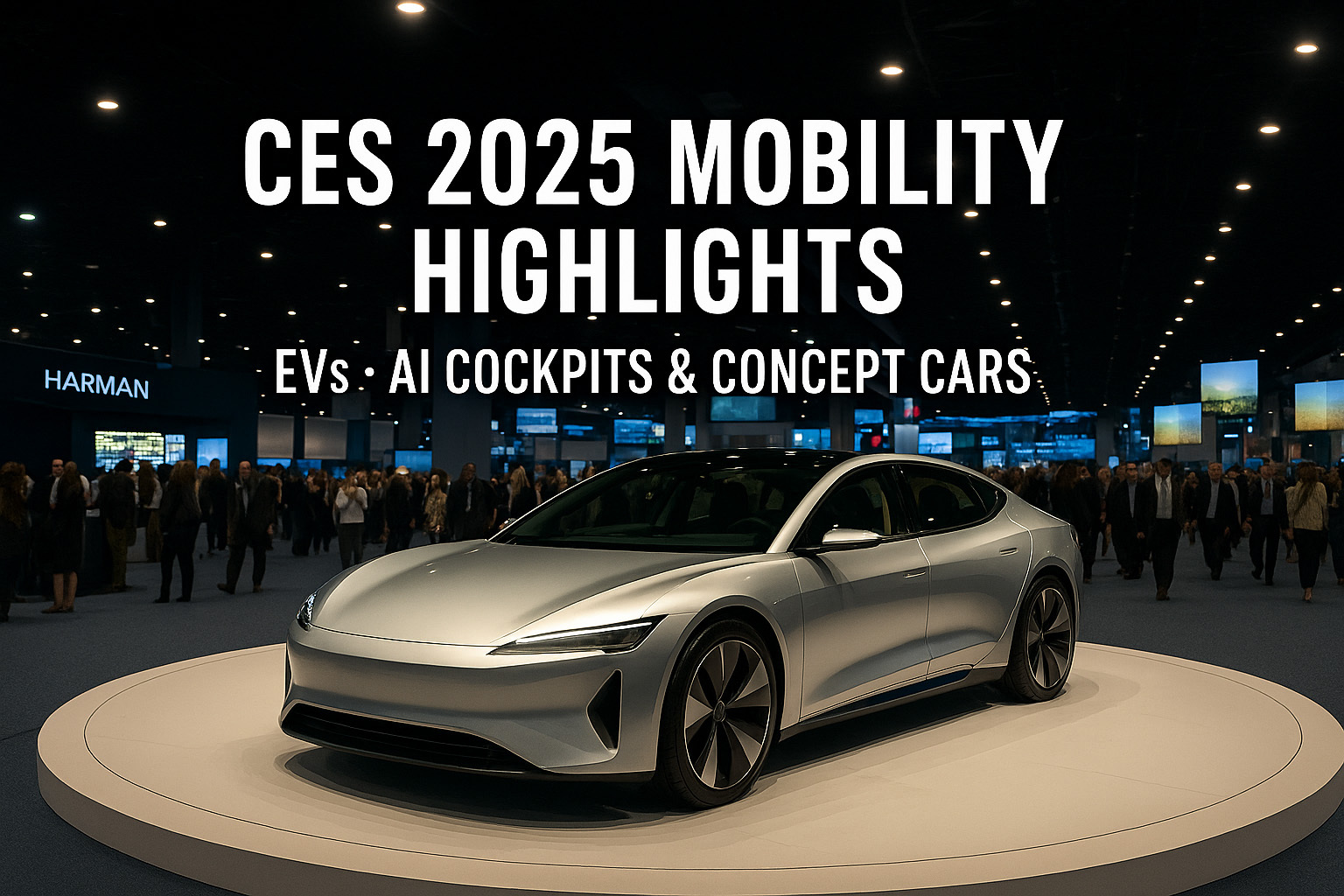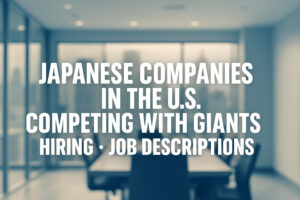CES 2025 Mobility Highlights: EVs, AI Cockpits & Concept Cars

Hello everyone—Tony Suzuki here from Eco Drive.
Welcome to my mobility recap from CES 2025, the world’s biggest tech showcase.
CES (the Consumer Electronics Show) takes over Las Vegas every January, and it’s nothing short of a global playground for cutting-edge innovation.
This year the automotive halls stole the spotlight, overflowing with next-level electric drivetrains, AI-powered cockpits, and wild concept vehicles that hint at the road ahead.
The videos embedded in this article are narrated in Japanese, but English subtitles are available.
The Sheer Scale of CES
The numbers alone are staggering: more than 4,000 exhibitors, 300-plus conference sessions, and attendees representing over 160 countries.
What began decades ago as a showcase for refrigerators, copiers, and other home appliances has exploded into the planet’s premier stage for every flavor of consumer technology.
For companies, standing out at CES isn’t just about bragging rights—it’s a marketing megaphone and a sales springboard all rolled into one. A headline-grabbing demo here can turbo-charge brand awareness and open doors to global distribution deals overnight.
Venues & This Year’s Theme
CES sprawls across Las Vegas—anchored at the Convention Center but spilling into Strip hotels like the Venetian and ARIA.
For 2025 the rallying cry is “DIVE IN.”
Yes, NVIDIA’s AI fireworks grabbed plenty of headlines, but in this post I’m zeroing in on mobility.
The calendar broke down like this:
- January 6: Media-only preview day
- January 7–9: Three full business days for the rest of us
Energy on the Floor—and a Truly Global Crowd
My first takeaway: the crowd was massive—easily dwarfing what I saw two years ago.
Journalists, investors, and engineers from every corner of the planet packed the aisles, with a babel of languages echoing through each hall.
Asia, Europe, and North America were all strongly represented, and I ran into more Japanese attendees than ever. CES 2025 didn’t just feel big; it felt borderless.
Surprises in the Mobility Hall
Doors officially opened at 10 a.m., but a huge crowd had already formed—and a human tidal wave poured in the second the ropes dropped.
The single biggest shock? The prime front-and-center booth in the mobility hall was owned not by an automaker, but by Korean appliance giant LG.
For a moment I wondered if I’d wandered into the wrong pavilion.
Their display featured a striking “exoskeleton” concept car—essentially the bare frame draped in outrageously sleek lighting and trim.
LG’s well-known LED design language translated surprisingly well to automotive form, turning heads and cameras in equal measure.
The takeaway is clear: big consumer-electronics brands are now diving head-first into the auto industry, and the media were all over it.
CES 2025 may be remembered as the year the line between “car company” and “tech company” blurred for good.
Honda’s New “0” Series EVs

Honda rolled out an all-new electric lineup dubbed the “0 Series,” launching with two concepts—a sleek coupe and an SUV.
The coupe stole the show: its wedge-shaped silhouette and scissor-style doors nod to the classic Lamborghini Countach, yet the surfacing and lighting feel unmistakably next-gen. By blending retro super-car cues with a minimalist EV aesthetic, Honda created one of the most talked-about designs of the week.
Pricing, battery specs, and on-sale dates are still under wraps, but the message is clear: Honda plans to re-enter the EV game with both style and ambition.
AFEELA by Sony Honda Mobility
The joint venture between Sony and Honda officially opened reservations for its first EV, the AFEELA, and the announcement drew a media stampede.
Reporters packed the press room, and even the president of Sony America took the stage to underline just how seriously both companies are taking the mobility space.
Starting price: US $89,900.
Given the car’s deep integration of Sony entertainment tech—think PlayStation-ready infotainment, best-in-class audio, and a dashboard-wide XR display—many analysts see AFEELA less as a traditional automobile and more as a rolling consumer-electronics platform. Deliveries are slated to begin in 2026, and early demand already looks strong.
China’s Zeekr Makes a Splash
Emerging Chinese EV brand Zeekr staked out one of the larger booths in the mobility hall, putting its tech-heavy crossovers and sleek shooting brake front-and-center.
The company has already confirmed a 2025 launch for Japan. As for the United States, executives told me they’re “watching CES feedback closely” before pulling the trigger on a formal entry plan. In other words, if the buzz they generated in Las Vegas translates to real demand, expect Zeekr badges to hit American roads sooner rather than later.
What Tesla’s Price Gap Is Really Telling the Industry
As new EV badges flood the show floor, Tesla has clearly become the point of reference for the entire segment.
Take Honda’s brand-new AFEELA-class coupe at $89,900; by contrast, a comparably equipped Tesla Model 3 rings in just north of the mid-$40 K mark—a spread of roughly fifty thousand dollars.
That yawning gap raises a blunt question: what extra value can up-and-coming EV makers deliver to justify a premium that size? Whether it’s bleeding-edge infotainment, unmatched design flair, or truly hands-off autonomy, the burden of proof now sits squarely on the challengers.
Tesla, by leveraging first-mover advantage, has cemented itself as the industry’s de-facto benchmark.
Talk to any supplier or analyst on the CES floor and you’ll hear the same refrain: every new electric model—no matter how radical—will be judged first and foremost against whatever Tesla is offering for half the money.

Suzuki’s Unlikely Pivot: From Kei-Cars to Robotaxis
One of the most talked-about corners of the hall wasn’t a Silicon-Valley EV darling at all, but the booth of Japan’s kei-car specialist Suzuki.
Instead of showing the company’s familiar pint-sized runabouts, the stand was all-in on autonomous mobility.
Suzuki announced a bold entry into public-transport tech, unveiling plans for a driver-less taxi network in the heart of Silicon Valley.
The pilot route will shuttle riders between the Google/Apple corridor and San José International Airport—a stretch infamous for traffic snarls and pricey rideshare fares.
If the project hits its targets, Suzuki could leapfrog straight from budget kei-cars to the cutting edge of smart urban transit—proof that even the most traditional manufacturers can rewrite their playbook when the market shifts.
Suzuki’s Road Map: A Fixed-Route Robotaxi Service by 2026
Suzuki’s robotaxi program is built around a fixed-route, scheduled service.
The company has already inked an agreement with the City of San José, and commercial operations are slated to begin in 2026.
With Korean and Chinese brands grabbing headlines in recent years, Japanese automakers have risked fading from the global spotlight.
Suzuki’s pivot into autonomous public transit is therefore drawing plenty of notice.
By stepping beyond its traditional forte—affordable kei-cars—and tackling “mobility as social infrastructure,” the company is signaling a truly forward-looking strategy.
If the 2026 launch stays on track, Suzuki could end up redefining itself not just as a carmaker, but as a player in next-gen urban transport.
The Cockpit Display Arms Race
One of the most crowded corners of the show floor was the cluster of suppliers focused on next-generation cockpit displays.
From spherical screens and ultra-sleek instrument panels to intuitive, full-width touch interfaces, virtually every booth was showing a bold new way to wrap pixels around the driver.
Where do they go from here? Three likely tracks are already emerging:
- Supplying full OEM display modules to established automakers
- Selling retrofit units into the aftermarket
- Launching their own consumer-facing brands for bespoke interiors
Most of the exhibitors are still refining the exact business model, but one takeaway is crystal clear: digitized dashboards are becoming the next big battleground in automotive differentiation.
How AI Is Reshaping the Auto Industry

Across the entire show floor, the single biggest storyline was AI.
Every automaker and tech supplier seems to be racing to apply generative and predictive models to:
- Elevate the in-car user experience
- Create a more comfortable, personalized cabin
- Accelerate the arrival of reliable autonomous driving
The industry is pivoting from a mechanical mindset to a digital one—a shift that opens the door wide for new players.
Traditional barriers such as the astronomical R&D costs of engines or multi-speed gearboxes kept most start-ups on the sidelines.
Electrification and software-defined vehicles have flipped that script.
Think of it as the leap from landlines to smartphones: core hardware is being simplified while intelligence moves to code.
Whoever masters the data—and the AI models that turn that data into seamless mobility services—will define the next era of transportation.
A Flood of New Entrants
Companies whose core strengths lie in batteries, sensors, cameras, and other digital domains are rushing into the mobility space.
What we’re witnessing is nothing less than a “once-in-two-centuries” revolution for the auto industry.
From Big Tech to agile hardware start-ups, an entirely new cast of players is lining up to redefine what a car can be—and the story is only getting started.
An Irreversible Wave of Change in the Auto Industry
The three tectonic shifts—electrification, digitalization, and autonomy—have gathered so much momentum that the industry can no longer turn back.
Headlines about slowing EV sales or Tesla’s earnings dip are only surface ripples; below the waterline, R&D continues to steam ahead at full throttle.
At Eco Drive we’re not an automaker—we operate on the distribution side through sales, rentals, and leasing. That vantage point forces us to ask a different question: How can we harness AI to add value after the factory gate?
The week at CES made it crystal-clear that finding those answers isn’t optional; it’s mission-critical for everyone in the mobility chain.

Rethinking AI at a Deeper Level
Up to now, most companies—including ours—have highlighted the “easy wins” of AI: slashing customer-support payroll, offering 24/7 chat, and other frontline efficiencies.
Those perks are real, but they barely scratch the surface.
It’s time to ask how AI can move the needle in a fundamentally strategic way.
To do that, we first need to get brutally clear on four points:
- Reconfirm the company’s long-term vision and north-star goals.
- Take an honest inventory of where we stand right now.
- Identify the gap—the distance between today’s reality and tomorrow’s ambitions.
- Explore which parts of that gap AI can close faster, better, or cheaper than any human-only solution.
Elon Musk’s Five-Step Playbook for Boosting Production Efficiency
Elon Musk often frames problem-solving around a simple—but ruthless—five-step sequence.
It starts with radical clarity about the work itself and ends with automation only after every ounce of waste is squeezed out.
The five steps, in order:
- Map the entire flow. Put every task, hand-off, and decision point on paper.
- Delete the obvious. If a step doesn’t add value, kill it.
- Simplify & optimize. Re-engineer what’s left until it’s as lean as possible.
- Speed it up. Once the flow is tight, increase the cycle time.
- Automate. Only when the process is rock-solid do you hand it to robots or software.
A common corporate misstep is to jump straight to Step 5—”Let’s automate it!”—without first doing the painful house-cleaning.
Musk’s order of operations is a useful reminder that AI and automation multiply excellence; they don’t create it from scratch.
Nail the basics, then let technology pour on the turbo.
Wrapping Up Our CES 2025 Mobility Coverage
From the show floor in Las Vegas, we’ve brought you a first-hand look at the most exciting mobility breakthroughs unveiled at this year’s world-largest tech expo, CES 2025.
Next up: a deep dive into the home-electronics halls. Check back tomorrow for that report!
Our Services
We offer comprehensive automotive solutions—buy, sell, rent, and repair in one place.
Car Sales
Browse our lineup of quality used cars with transparent pricing and up to a two-year warranty on select models.
View InventoryAuto Repair
Get expert service from our certified Toyota Master Mechanic. We primarily service Toyota vehicles.
Schedule ServiceTrade-in / Sell
We pay top dollar for your vehicle—especially hybrids. Count on fair, transparent appraisals.
Get EstimateCar Rentals
Choose between fuel-saving hybrid rentals and a Tesla with Full Self-Driving Capability—both at competitive rates.
Reserve Now





